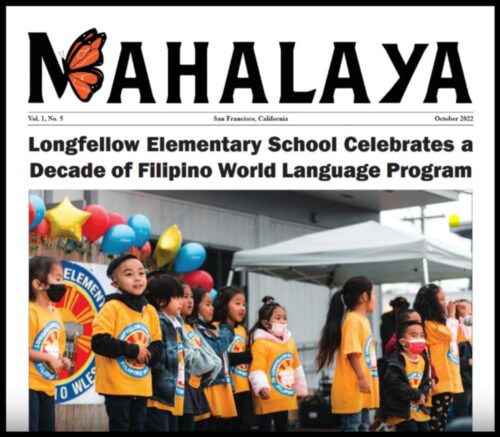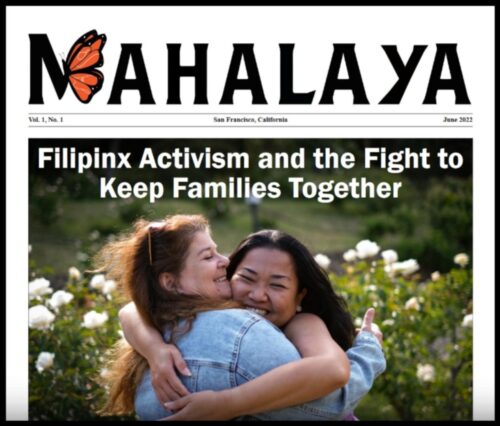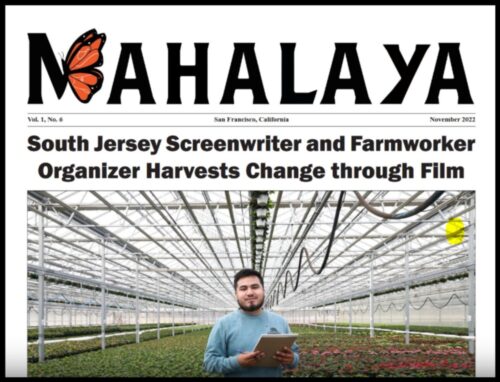Happy Birthday, Mahalaya!
By Gene Thompson
Mahalaya, the brainchild of former City College journalism student Casey Ticsay, is having a birthday bash, and you are invited!
The free, monthly community newspaper celebrates its first year of serving San Francisco’s Filipino community on Saturday, June 3, from 6 to 9 p.m. at Problem Library, 1288 15th Ave., San Francisco.
The public will sample Filipino food and share desserts with the writers, designers and organizations that have contributed to Mahalaya’s remarkable success over its first 12 months.

Artists will present their work, including “a gallery showcase of every Mahalaya issue printed over the first year,” according to the newspaper’s announcement of the event. Striking photography and graphics are a hallmark of the paper.
Founding Editor-in-Chief Ticsay earned her master’s degree at USF after attaining a bachelor’s degree at SFSU and completing courses in journalism at City College of San Francisco, where she wrote articles often critical of the administration’s budgeting practices.
Ticsay discusses the guiding philosophy of Mahalaya in the abstract of her University of San Francisco master’s thesis, proposing “a shift toward a thick solidarity approach to news gathering and media-making in both professional and community journalism.”
Staff writer and managing editor Bernard Remollino explained that the notion of thick solidarity “drives every decision we make.”
Defining the concept and clarifying its importance to Mahalaya, Remollino said, “Thick solidarity is deliberate action rooted in an understanding of the shared stakes, the shared investment that comes through collaboration, not looking for a story simply to fill pages but to empathize…to care about how the outcome may affect how people can live in dignity.”
He spoke also of the interconnected struggles of Filipinos, Black people and others who have suffered from colonialism, enslavement and other social oppression.“We see it rooted in traditions of anti-blackness, of anti-queer, anti-trans…. Fostering an awareness of that is part and parcel of how we run as a paper…. The paper, its ethos and its spirit are very much aligned with the movement for broader Black liberation…. It’s reflected in this dynamic of thick solidarity.

Remollino earned his doctorate in history at UCLA, where he had to live in his car because his pay as a teacher’s assistant at the university was so low. He’s doing better now, commuting from his home in the Sunset District of San Francisco to teach classes at San Joaquin Delta College in Stockton.
He’s a colorful personality in more ways than one. While profiling Filipino tattoo artist Tito Gavina for Mahalaya, he asked to have an unfinished tattoo of his grandmother on his back embellished in a way that honored “the unbroken connections with my ancestors.” Gavina “tattooed my entire back from shoulders to buttocks over the course of thirty hours.”
Remollino is the primary organizer of the June 3 anniversary event, which had to be relocated from Chinatown to the Problem Library when the original venue fell through. But the new venue turned out to be perfectly suited to Mahalaya’s purpose.

“The space is usually used to facilitate young, upcoming artists to go into a career in the arts,” Remollino said. “I was told that in the last two or three years 80% of the students at the space were young Filipinos in and around the Bay Area. The connection is deeper than I could have imagined. Call it serendipity if you will. Things seem to work out.”
A devoted core of contributors has enlivened Mahalaya’s pages with vibrant portraits of the South Pacific Islanders and Filipino residents in the South of Market and Excelsior districts.
But the paper’s role as a community builder extends beyo

nd the streets of San Francisco.
While Remollino says Mahalaya collaborates closely with the Filipino Community Center in the Excelsior District, “the folks we interview, that are our artists, writers and photographers, are located across the United States, mostly on the Pacific Coast, but we have folks in D.C., in New York, in Boston… We have some folks in Arkansas that are in rising Filipino communities out there, through our public health initiatives and performance art, theater, spoken word, that we would love to have come out and join us.”
